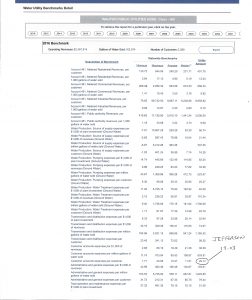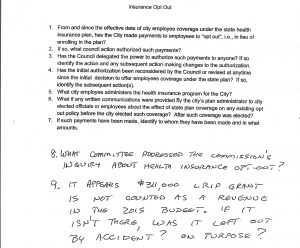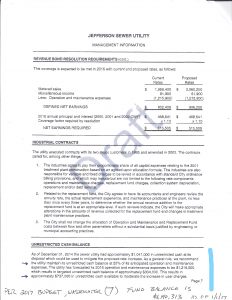The study was supposed to take 8-10 weeks. It was approved in July 2016. The consultant was to interview all of the relevant people and discuss recommendations with the stakeholders. There was not going to be a final report. Months later as the study dragged on, Alderman Brandel called the process ridiculous. Eventually, after more than a year, and without the consultant interviewing six of the Commissioners, the final product was made available with 19 recommendations. It leads off with some rate information.
Utilities are a little bit like a carpool. If you share the cost of commuting with three friends, your share will be one quarter, or 25%. If one friend moves away, your share of the carpool expense would be a third, or 33% of the total. That increase of 8% going from one quarter to one third is a 32% increase. This is about what happened to water rates when Tyson closed. Tyson was about 27% of the water demand. Just as the car in the example uses the same amount of gas, insurance and maintenance whether there are three or four occupants, the water system has all the same wells, pipes and related costs even though Tyson is gone. For the average residential customer, water rates went up about $8 per month, and electric went up a little over a dollar per month. Jefferson now owns significant excess capacity. It all must be maintained. What is missing is Tyson’s contribution.
Perhaps to try to cast the utility in a somewhat negative light, the study says water rates are 20% higher than the average in the county. (It ignores the fact that combined water and electric bills for the average resident are the lowest in the county.) Post Tyson, the PSC raised the average Jefferson residential water rate 35%, which means Jefferson was charging 15% less than average before Tyson closed. So things were evidently being managed rather well.
Over a recent 25 year period, about 38% of the water main was new. Investment in infrastructure continued even with the low customer rates. The Utility has less than $1 million of debt, which was used to address radium after that federal standard changed. The point is, the Utilities did not suddenly become inefficient because Tyson closed. The consultant noted that because the rates were recently changed, Jefferson will improve its ranking over time as all the other utilities get increases.

Another study “problem” is billing cost. A chart shows Jefferson’s time spent per customer as three times that of Waupun’s. The PSC data shows quite a different picture with Waupun’s customer account cost as $29.14 per customer, while Jefferson’s is $19.03, only 2/3ds of Waupun’s cost. 
And Waupun has AMI, automated metering and billing. Before you get too excited, it cost them about $1,700,000. Which, without any financing costs, is about $85,000 per year over a 20 year expected life. Jefferson is old fashioned and uses meter readers. Meter readers total one FTE (2080 hours) at about $16-17 per hour adding WRS and SS for a total of about $40,000 for the year. AMI is not a decision to be undertaken lightly. The Commission has money budgeted this year to review the math in finer detail, but AMI is no magic bullet. It is like running a city wide wifi system with radios in the meters. It still needs constant looking after by staff. It is probably not cost effective to change at this time, but it is worth a look periodically to see when it might make sense by generating real savings.
Another “too much billing time” study finding- two customer service areas, a walk up window indoors and a drive up outside. The consultant determined there were about 48,000 window visits per year. The recommendation was to close the service windows and have people make appointments. For argument’s sake, what business with 48,000 customer visits would say it makes sense to close the customer access points and require a phone call or email to make an appointment? That would increase the time necessary to help them, and probably anger quite a few, beyond just being very inefficient.
Fortunately, the consultant’s 48,000 number is wrong by a factor of about 5. The real number is about 700-900 per month, or roughly 10,000 per year. Staff did a test closure of the drive up window for several months. It was counterproductive and poorly served the handicapped, elderly, moms with kids and anyone else in their car by making them park and come inside. Inside, it created longer lines as only one window was available. That trial has mercifully ended. During a rougher part of the winter, the decision was made to allow people to use the drive up. The consultant’s proposed “fix” turned into a self created problem which has now been solved.
One last comment on the “excess billing cost” issue – the consultant advocates adding the City Finance Director at the top of the office staff column of the organization chart-adding people instead of reducing staff! How does that save any money?
The study doesn’t have any benchmarks for staffing. The number of FTEs (one Full Time Equivalent= 2080 hours per year) for similar operations is missing. It seriously affects the analysis of the Wastewater department. Over several budgets, the authorized positions in Wastewater continue to show a chief plant operator even though the City Administrator stated numerous times it had been eliminated. There is a half time shared position that is said to be vacant, but the person appears to have been working in the Public Works Department, full time? Both the Chief Operator position and the shared position were on the Council agenda on March 6, 2018.
The Budget’s Authorized positions don’t match the employees actually there, and the study describes a filled position as vacant. At least the 2018 Authorization has cut the Wastewater FTEs to 4, which the Superintendent says in his state required annual report is enough. And the study says the lab job is really .5 FTE, so maybe Wastewater needs 3.5 FTE. Where is some data from comparable cities to know the answer?
The study does point out that pay differentials exist if Water and Wastewater are combined. Wastewater operators are paid $6.56 per hour less at the 2016 control point, which includes retirement and social security. If, as stated by some authorities along the way, the Wastewater staff will be brought up to parity, that would cost $27,290 at the control point. And if the weekend pay goes from 7 hours of overtime to 18 hours at straight time as recommended, the additional cost could be as much as another $12,792 for a total of about $40,000 of new expense. Not a savings. The 2018 Wastewater wage budget shows an increase of $51,875 more than the projected 2017 total amount. Not a savings.
Two substantial issues about the operation of the Wastewater department were missed by the study altogether. Two years ago, Baker Tilly, the same firm the consultant works for, pointed out that the Fund Balance was excessive and could be used to reduce rates and the system suffered from a troubling percentage of clear water inflow and infiltration.
Unrestricted Fund Balance recommended by the auditor is 25% of estimated operation and maintenance expenses. For 2018, Wastwewater has O and M expenses of $1.1M, 25% of which amounts to $275,000. The budget shows a total Fund Balance of $2,417,933 as of 1/1/18, which for the first time includes the equipment replacement account of $1.17M. The unrestricted portion was $673,000 at the end of 2017, for an excess on hand of $398,000. Before rates are raised, this excess cash should be considered to offset any increase.
And the inflow/infiltration problem has only gotten worse. Baker Tilly pointed out that exceeding the industry average of 25% drives up costs and should be researched and resolved. For 2016, the rate appears to be 55% meaning that more water is entering the treatment plant from outside the system than is being billed to customers. That number will probably be even higher for 2017 as Tyson was still operating for half of 2016, putting substantial water in that was billed. Infrastructure would appear to be in poor condition, and although Wastewater has excessive Fund Balance, there appears to be no plan to identify and develop a solution for the problem. (Fort Atkinson is currently testing its entire system at the cost of $150,000.)
It looks like Wastewater may be overcharging for and under maintaining the sewer system. When concern for the aging sewer pipes on Church and North Street was cited as a reason not to replace water mains with lead joints, the Utility Commission had to push the issue to get the new water pipes in. The old sewer lines were just paved over. Is this the way you want to see a combined department be run?
Another unquantified potential expense the study left out is potential raises for various managers if the proposed organization chart is adopted. The City’s compensation system is designed by Carlson Dettman. A standard part of the Carlson Dettman system is that job changes adding new responsibilities are the basis for pay review. One factor is the size of the budget a person answers for. If the City Administrator goes to the top of the chart with the Utilities in it, his budget will more than double from $12 million to $25 million. Comparable positions with similar duties elsewhere are used to come up with market pay for the new set of responsibilities. Plymouth, a city of similar size, has an organization chart like what is proposed here, with the City Administrator at the top of the city operation and the utilities. From the most recent data I could find (2013), the Plymouth Administrator was paid $17,000 more than the Jefferson Administrator. That should be reviewed as well as whether the Finance Director, Wastewater Superintendent and perhaps the Engineer will all qualify for some increase. Again, this is all new expense, not a savings.
Did the City Administrator fail to tell the Council of this possibility? He advocated for the Carlson Dettman system. And there is a prior history of strange things that just happen to positively affect his pay. In September, 2009, the City Administrator was notified by the State of Wisconsin that one condition of the City getting state health insurance was the requirement to end payments to employees to opt out of insurance. The City approved the state program in October, effective January 1,2010.

The second paragraph from the bottom of Larson’s letter says opt out payments to nonunion employees should end what would have been January 1, 2010. Instead of following the contract, payments continued to the Administrator and a few others. There is no reference to opt out payments in the current personnel manual. so how do they continue?
The written questions above were submitted to the Council twice. After a records request showed the payments continued to be made over the years at the rate of about $7,000 to $9,000, the Administrator did mention as an aside at an unrelated meeting that the “City determined’ to do that. Unfortunately, it doesn’t appear that there is any record of that decision. And would the Council have done it had they received the email from the state and been fully informed that it was prohibited? Were they kept in the dark?
In 2015, the state legalized the opt out program effective January 1, 2016. They decided to pay $2,000 for an employee to waive insurance. In 2015, the Administrator received $8,900 under the unauthorized program. The Utility Commission, seeking to save some money in 2016 as would be allowed by the changes, requested that the City adopt a policy allowing its employees to opt out. The Administrator handled it before the Finance Committee. Surprise! There wouldn’t be a new city policy to that effect. And there appears to have been no disclosure of the $2,000 amount either. So, the payments continue to 3 people at the higher amount, even though no one has been able or willing to produce any official action as to how it could be paid in the face of the contract prohibiting it, the 2012 Personnel Manual or any policy created once it was able to be done in 2016.
Want to save some money? Adopt an opt out policy today. Use the money paid to three people (estimated $24,000) at the rate of $2,000 per person. If 12 people sign up, the net savings would be about $180,000. The Council probably hasn’t gotten that information from the Administrator. As to the Carlson Dettman question above, the Council could consider calling Charlie Carlson at an open meeting and ask if the changes proposed would support a pay increase for wastewater operators, the Administrator and perhaps others, and what sort of comparables would be used to arrive at an appropriate salary. Then net out all the “savings” after the Wastewater increases, the filled vacant positions and the management salary adjustments. More savings from RFPs for professional services could help, too. The Commission lowered its audit contract by $20,000 by an RFP process. The Commission recently got an engineering bid from a firm different from the City’s long term no bid firm that was 77% less than the city’s regular engineering firm. But maybe the Utilities should close the drive up window . . .
For all of the communication/collaboration issues mentioned, it takes two to make it work. Those issues could be resolved by the City Administrator’s attendance at Commission meetings . After all, he is a (nonvoting) member by city ordinance. If he has material information, it should be presented so it can be considered.
And finally, remember, the study DOES NOT recommend the Commission be abolished even though the resolution presented to the Council on November 21 says it does. Just one more fake fact.
It ain’t broke. Don’t “fix” it!!
If you have a question, you can email me at moneygames@mail.com. I will answer questions as I can and update this from time to time.
Remember to VOTE NO on April 3.


